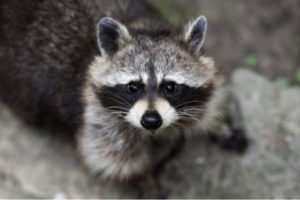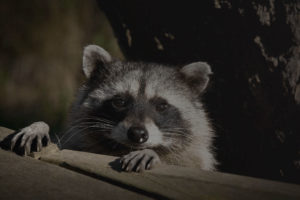Biology & Behavior
Adult raccoons in Utah may weigh from 10 to 30 pounds, are 2 to 3 feet in length, and are about 16 inches tall at the shoulder. Adult males may occupy territories of 3 to 20 square miles, compared to 1 to 6 square miles for females. Raccoons do not hibernate during the winter, but may sleep several days to a couple of weeks during extreme cold periods. They are nocturnal and solitary except when breeding or caring for their young. Breeding usually occurs from January to March, with females mating only once a year. Usually less than half of yearling females will breed, while adult females normally breed every year. After a gestation period of about 63 days, an average litter of 3 to 5 young are born usually in April or May. The young weigh about 2 ounces at birth, open their eyes at about 3 weeks, and are weaned from 2 to 4 months of age around late summer. Some young may disperse in late autumn, but all are driven away by the female before her next litter is born. A female with young may attack if cornered, so caution should be taken if a mother and young are encountered in an attic or other enclosed space. Raccoons generally have a short life span. Fifty to seventy percent of all populations consist of raccoons under one year old. Raccoons rarely live to the age of 12 years in the wild. Raccoons are omnivorous and will eat either plants or animals, depending on what is available. Plant foods may include fruit, vegetables (especially sweet corn) or nuts. Animal foods may include grubs, crickets, grasshoppers, large insects, crayfish, clams, frogs, worms, fish, turtles, bird eggs and nestlings, and small mammals such as squirrels, rats, or mice. In urban areas, raccoons may feed on dog or cat food, fruit on trees, garden vegetables, or trash can garbage.
Noises
What Does a Raccoon Sound Like?
Thought you heard a raccoon? Listen to an audio recording (mp3 file) of raccoon noises and sounds.
Vocal Noise
Raccoon sounds range from the vocalizations the animals use to communicate with each other, to the noises they make as a result of their rustling, scurrying, and other activity. Known to be extremely vocal creatures, raccoons interact by using more than 200 different sounds, which include purring, chittering, growling, snarling, hissing, whimpering, and even screeching like owls. Baby raccoon sounds include mewing, crying, and whining.
Movement Noise
Even when raccoons are quiet vocally, they still make noise. The sound of an animal rustling or scurrying about the attic or in the chimney is a common sign that a raccoon has moved in. Typical raccoon sounds also occur when the pests walk across rooftops, construct their dens, or attempt to gain entry through holes or other small openings that lead to attractive denning sites. People tend to hear raccoon sounds most frequently at night due to the nocturnal behavior of the pests.
Tracks

Raccoon footprints are hand-shaped with a diameter that measures 2-3 inches across. They register five finger like toes in both front and hind feet, and also often register small claws. Their tracks are asymmetrical. The innermost toe is smallest and further towards the rear of the foot than the other toes, which allows left and right tracks to be differentiated. Their foot pad is roughly c-shaped. Front tracks have longer toes that are more spread apart. Hind feet often register a larger palm and heel pad.
Raccoons have a unique walking gait that they utilize when traveling and foraging. This unique walking gait results in a trail pattern where front and hind tracks from opposite sides of the body register next to each other. Step lengths in this gait vary from 10-18 inches. Raccoons will also utilize lopes and gallops when avoiding danger.
Scat
Adult raccoons in Utah may weigh from 10 to 30 pounds, are 2 to 3 feet in length, and are about 16 inches tall at the shoulder. Adult males may occupy territories of 3 to 20 square miles, compared to 1 to 6 square miles for females. Raccoons do not hibernate during the winter, but may sleep several days to a couple of weeks during extreme cold periods. They are nocturnal and solitary except when breeding or caring for their young. Breeding usually occurs from January to March, with females mating only once a year. Usually less than half of yearling females will breed, while adult females normally breed every year. After a gestation period of about 63 days, an average litter of 3 to 5 young are born usually in April or May. The young weigh about 2 ounces at birth, open their eyes at about 3 weeks, and are weaned from 2 to 4 months of age around late summer. Some young may disperse in late autumn, but all are driven away by the female before her next litter is born. A female with young may attack if cornered, so caution should be taken if a mother and young are encountered in an attic or other enclosed space. Raccoons generally have a short life span. Fifty to seventy percent of all populations consist of raccoons under one year old. Raccoons rarely live to the age of 12 years in the wild. Raccoons are omnivorous and will eat either plants or animals, depending on what is available. Plant foods may include fruit, vegetables (especially sweet corn) or nuts. Animal foods may include grubs, crickets, grasshoppers, large insects, crayfish, clams, frogs, worms, fish, turtles, bird eggs and nestlings, and small mammals such as squirrels, rats, or mice. In urban areas, raccoons may feed on dog or cat food, fruit on trees, garden vegetables, or trash can garbage.
Damage
Most towns and cities in Utah have raccoons living within city limits. Because raccoons are active by night (nocturnal), they are seldom seen. Of all the wild animals that have adapted to city life, raccoons are probably the most destructive. Raccoons cause problems when they lose their fear of humans and move into urban areas to live. Problems include feeding in garbage cans, establishing dens in chimneys and plugging them with nest material, tearing off shingles or fascia boards to enter an attic or wall space, or causing damage to gardens and fruit trees. Raccoons also may carry fleas, ticks, lice, distemper, mange, rabies, and canine and feline parovirus. The results of recent blood tests conducted on raccoons in Utah indicated that over 80% of those tested had been exposed to rabies as indicated by the presence of a rabies titer. Raccoon feces may also contain the roundworm egg (Baylisacaris procyonis). Humans, especially children, that come into contact with raccoon feces containing eggs of this roundworm can also become infected. Clinical symptoms depend on the number of roundworm larvae present in the body and their location. If the larvae migrate to the eyes or brain, blindness or death can be the end result. Raccoons can also threaten the health of other mammals. They can carry Aleutians disease which is a virus that affects other fur-bearing animals. As such, it poses a major threat to Utah’s fur industry. In addition, raccoons entering the buildings where mink are raised may eat off the mink’s feet through the wire mesh in the bottom of their cages. The injured mink usually die soon after the injury. Raccoons also cause problems in rural areas by raiding chicken coops or poultry farms and killing many birds, only consuming a portion of the total number killed. Damage to agricultural grain crops and raccoon predation on bird nests are other common problems.
Pictures
Commonly ASKED QUESTIONS?
What do you do with trapped animals?
That answer depends on the state in which you live. Each state has their own laws that dictate what we must do when it comes to controlling wildlife on your property. In some states, we can trap, transfer and release the animals. In some states we can trap the animals, but we can only release them back onto your own property. If you don’t want the animal released on your property, it must be humanely euthanized. Sometimes we don’t even need to trap the animal and a simple exclusion device (one-way door) can be installed to allow the animal to exit your home and be locked out.
How much does it cost to remove an animal?
There are a number of factors that determine pricing; location of the animal (i.e. – chimney, attic, crawl, wall void, living area), condition of the animal (i.e. – sick, aggressive, dead), location and condition of the property and time of year (i.e. – weather condition, offspring present?). Generally speaking, pricing will vary by location and species for just the animal removal and that pricing usually does not include the entry repair.
I think I have birds in my chimney, can you get them out?
The answer to that question is most likely “Yes”, but are you sure what you’re hearing is birds? Raccoons easily invade chimneys and they have their litters on the smoke shelf of fireplaces. The sounds baby raccoons make are often mistaken for birds in chimneys and removal can be difficult. The only birds that nest in chimneys are chimney swifts and they’re federally protected, so removal can’t be performed, but exclusion can be – once they depart. If you have a pre-fabricated chimney and birds fall between the cooling tubes, removal is nearly impossible.
How soon can you get here?
Office hours vary from franchise to franchise, but generally speaking, office hours are 8am – 6pm M-F and 9am – 3pm on Saturdays.
Clients Testimonials
OUR EXPERTS WILL SOLVE THEM IN NO TIME.
Have Any Pest Problems?
Navigations
Contact Information

At Critter Removers we're committed to providing you with the highest level of services and solutions to best fit your pest or critter control needs.


